

Exploring our past to sort out myth from reality
Share this Page on
Facebook or Twitter

These are the voyages of the TimeShip Anachron.
Our Mission: To boldly explore the past, dispelling
mythinformation and mythconceptions
of American History along the way.
 Visit us on Facebook
Visit us on Facebook


These are the voyages of the TimeShip Anachron.
Our Mission: To boldly explore the past, dispelling
mythinformation and mythconceptions
of American History along the way.

Exploring our past to sort out myth from reality
Share this Page on
Facebook or Twitter
 Visit us on Facebook
Visit us on Facebook
Meet MythAmerica Series

The American Way of Business, Part 1:
Un-American Activities?
A while back, someone on my Facebook feed posted an interesting info-
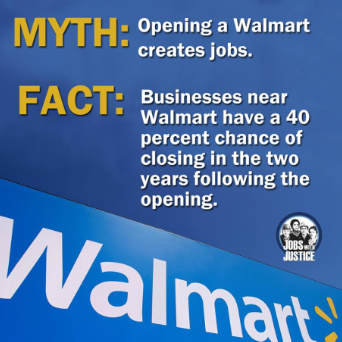
The implication is obvious. Numerous articles on the Internet confirm the details. Consider this excerpt from the New York Daily News, about efforts in 2011 by Walmart to establish stores in Metropolitan New York.
The big-
If history is any indication, nothing could be further from the truth. Chicago’s struggling West Side learned the hard way that Walmart’s stores destroy more retail jobs than they create.
In 2006, the big-
Instead of growing Chicago’s retail economy, Walmart simply overtook it -
Researchers at Loyola dubbed Walmart’s store a wash -
Chicago’s cautionary tale isn’t isolated. Countless communities, and peer-
There is an unspoken assumption in articles like this, and I’d like to speak that assumption clearly in this blog series. The key term in the quote above is “Main Street.” When a “big box store” like Walmart moves in, “Main Street” dies.
The author above doesn’t define what is meant by “Main Street,” but what I suggest to you is that it has long been a “short hand term” for the idea that The American Way of Life has, throughout our history, been based on the economic model of the “small independent business.” The promise of The American Dream has been that with hard work and integrity, any man can become a financial success, provide a good and prosperous life for his family, and ensure a continually “better life” in the future for his children and grandchildren. And the most typical outlet for that hard work and integrity would be to be an entrepreneur, provide a service or product of superior quality, and establish a prosperous, well-
Each such Main Street in this myth is viewed as being similar to the main street in the fictional Busy Town that my daughter, now in her 40s, remembers seeing in the bubbly, optimistic children’s books of her youth (and later TV shows and video games of her children’s youth) illustrated by Richard Scarry.
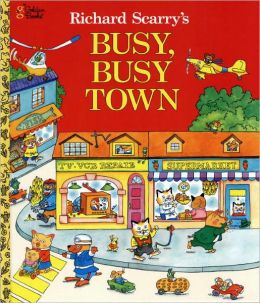

Or maybe just like the other main street of her childhood, Sesame Street. There’d be a bike shop, a bakery, a flower shop, a fix-
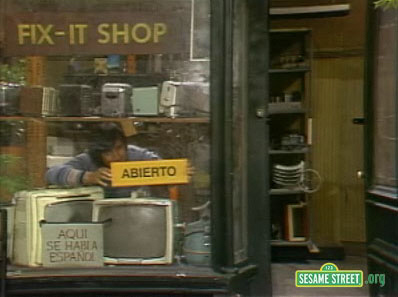
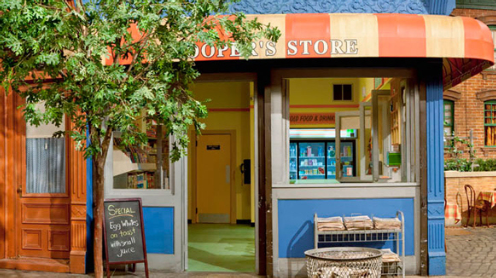
This idea of American Society being anchored to such a bustling little Main Street has long endured—in spite of the fact that for well over a century, “bustling small town America” has been dwindling, and has long since been almost snuffed out of existence. I even have a number of friends who seem to base their economic theories—and their speculation on how we can “rescue America” from imminent financial collapse—on superimposing a template of that mythical Main Street and its theoretical underpinnings—on top of a whole Babylon of multi-
Too many Americans think in terms of what I have elsewhere termed their own historical “Time Ghetto.” All they really know about American history is what they have lived through themselves, or what they have gleaned from snippets of stories from their parents and grandparents, from fading Kodachrome and black and white photo prints in family albums, and what they have absorbed from pop-
They evaluate current circumstances, whether in politics or economics or even religion, as being only the outcome of negative factors extant since they themselves reached adulthood. All time before that was America’s Glory Days. For many people I know, when “looking backward” those Glory Days begin with the 1950s and extend back through our glorious triumph in WW2, our glorious triumph in WW1, the heyday of Teddy Roosevelt, the Gay (Eighteen) Nineties, the period of our glorious Conquest of the West, and on back into the mists of history.
And, especially those with a religious bent, too often conclude we are just on the edge of a biblically-
The issue of the evil, “un-
Sorry folks. Reality Check:
Before 1880 businesses like department stores did not exist; what did exist were neighborhood dealers, small dry goods firms, and large wholesalers that fanned out through distributing outlets into cities, towns, and villages. In the next twenty years, however, cities throughout the country would be filled with large retail establishments—multifloored, multiwindowed buildings of great concentrated selling power. … Substantial middle-
Department stores overshadowed the scene through the sheer rapidity and size of their expansion, which started in earnest, if chaotically, in the early 1890s as merchants began to tack new wings onto older stores, often creating “shreds and patches without unity or dignity,” as one architect complained. They, along with retailing chains and mail-
NO, Walmart didn’t invent the tactic of offering a centralized shopping experience and a wide variety of goods, able to cut prices because of volume production and distribution, able to take advantage of cheap labor in far-
More than other businesses, department stores revealed the totality of what the American economy was producing and importing. In the 1880s, most stores had only fifteen small departments, but by 1910, many offered upward to 125. Siegel-
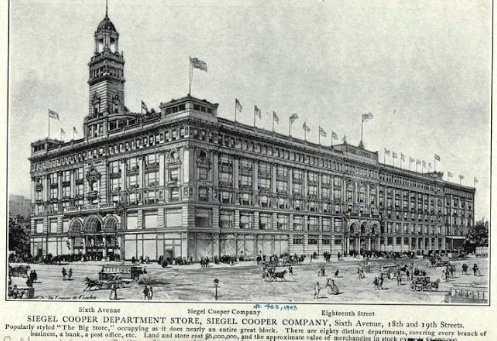
Yes, you may be used to a “department store” like JC Penney or Belk in your local mall. The term originally just meant that they sold more than one type of goods, in various “departments.” But as noted above, by the turn of the last century many went far beyond just clothing and household goods departments.
Stores from Bloomingdale’s and Siegel-
Macy’s, the first large retail store to merchandise kosher foods, according to the store’s food buyer, William Titon, by 1914 was selling “all the rare tropical fruits and vegetables, irrespective of season.” Its food department had dietetic foods (granola, wheat bran, wheat flakes, peanut butter, whole wheat foods, yogurt, and so forth); 265 different kinds of wine, claret, and champagne; also an assortment of beers, gins, brandies, rums, whiskies, and liquors of “all descriptions,” and, under Macy’s own label, Red Star Brand cocktails (pre-
Wait a minute … you mean that health foods and pre-
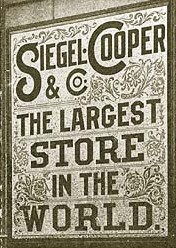
On September 12, 1896, the New York Times announced that the store would open that night at 7:30, and thus “end a period of uncertainty for thousands of women who had a live interest in the scheme to equip New York City with a department store which should be the rival of any such establishment in the world.
“The Times reported that 150,000 people had attended the opening of what they called “a shopping resort.” The store was prepared for 190,000 visitors a day, and employed 8,000 clerks and 1,000 drivers and packers. In addition to the usual vast array of merchandise of department stores then and now, Siegel Cooper had a telegraph office, a long-
But wait…there’s more:
In addition to the expected goods – silverware, linens, clothing and china, for instance -
Francis Morrone and James Iska, in their “The Architectural Guidebook to New York City,” wrote “The quintessential New York experience was to buy a five-
Of the 124 departments, some were found in no other shopping establishment. The store offered both a dentist and doctor office, a beautician and a barber shop, a post office, an office for theatre tickets and a bank. In the basement the store operated its own plant for power, lighting, heating and ventilation. The bicycle department had a track for test rides.
So just how well do you think the mom and pop businesses in the area flourished after this behemoth opened?
Oh, but it wasn’t just a giant flea market with all this stuff scattered about. Visiting it to shop was an experience in itself, more akin to a day at Walt Disney World than to a day shopping at a modern strip mall. Or Walmart.
The $4 million that Siegel and Cooper spent on their “gracefully ornamented” building bought them the largest department store in the world. The scope of the structure was unheard of – six stories tall and a full block wide, stretching back to Fifth Avenue. Lavish Beaux-
(That grandeur is still there today, although as you see in the current picture from today, the building is now full of separate stores such as Bed, Bath, and Beyond.)
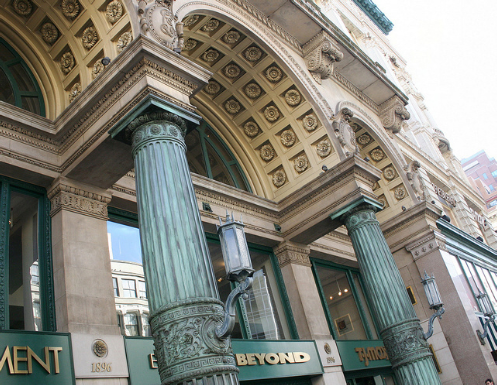
Two gigantic bronze, fluted pillars supported the triple-
… Central to the first floor was a fountain in the center of which was a 13-
In a bid to connect the store’s cultural reputation to the famous 1893 World’s Fair Columbian Exposition that had been held in Chicago, this statue was an authorized replica of the 65 foot statue that had dominated the landscape of that fair.
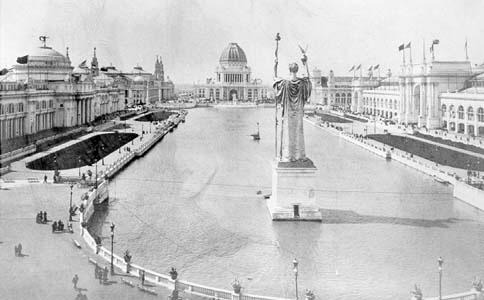
The miniature version was immediately recognizable, as you can see in this colorized photo from the early 1900s.
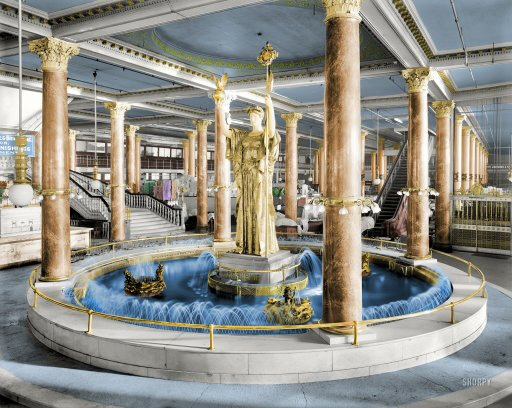
Costing $15,000 [adjusted for inflation, that is over $400,000 in modern dollars!] it was brass with face and arms of white marble. Colored lights illuminated the fountain. “The figure is a heroic one of a female in classical garb,” said The Times. “The arms are extended upward. One hand supports a staff of Liberty, the other a golden orb, on which an eagle perches. On the globe glows an electric star, the light of which is in vacuum and opalescent…”
And so the business of the Department Store Behemoths began in earnest. Seigel’s was just one of the earliest manifestations. I do remember in my childhood in the Midwest in the 1950s hearing of Macy’s Department Store in New York.
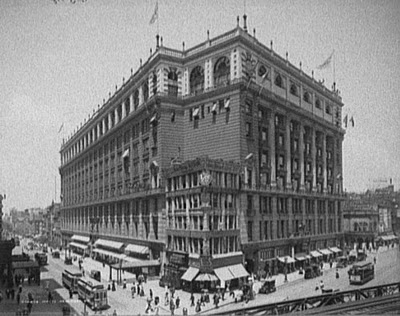
You couldn’t miss knowing that name, because they sponsored the famous Macy’s Thanksgiving Parade that has been televised for many years, right up to the present. Starting in 1927 the most popular feature of the fair were the huge helium balloons of currently popular characters. The very first, in 1927, was Felix the Cat.
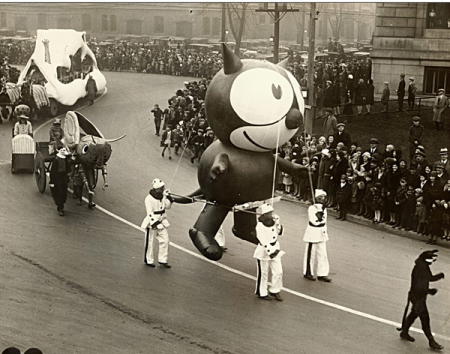
Mickey was added in 1934.

Superman was featured in 1940.
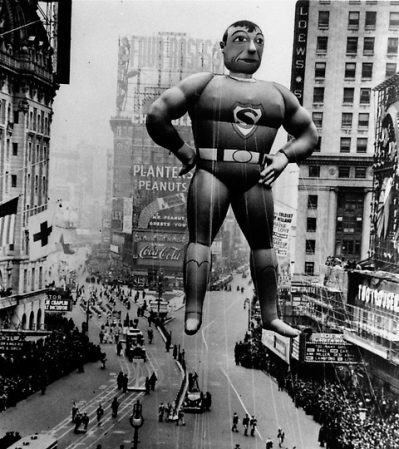
Here’s another one from 1940. It’s not quite clear why this fellow was included–it’s Eddie Cantor, past his prime and never all that popular with kids, but someone must have thought he’d make a jazzy balloon.
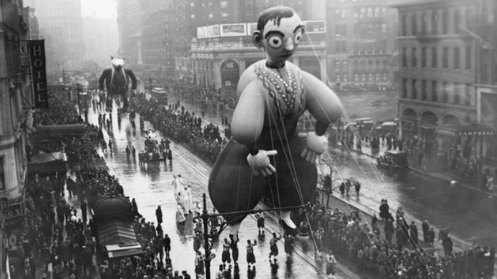
Of course the parade has kept pace with the times, and as characters like Cantor and Mickey have faded in appeal, new ones have been added!
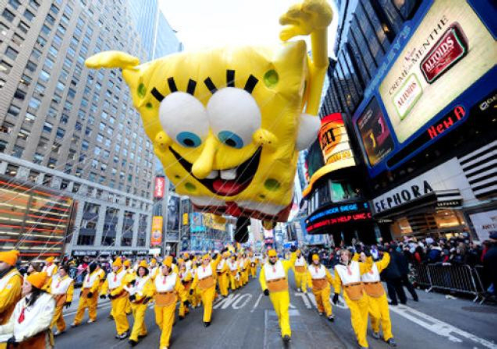
Yes, I’d heard of Macy’s, but always just attached to the word “parade.” Until only recently, I had thought that Macy’s was one of a mere tiny handful of iconic “metropolitan department stores.” I was wrong. The most famous incarnation of the store, shown in the picture, was built on Broadway in 1902. And within a short time it was only one of many monster stores strewn across the nation. They came on the national scene practically over night, and “changed the game” of the retail system in the country almost single-
The Retail Wars of the 1890s
The success of the mass market retailers was due to more than their capacity to summon large amounts of capital or to offer a huge assortment of goods under one roof or through a single catalog. There were other, more direct means, which included alliances among merchants, reformers, and state governments to defeat the opposition. In the 1890s, retail wars, emblematic of the turmoil involved in what Alan Trachtenberg has called the “incorporation of America,” erupted (especially in the western states) to challenge even the legality of department stores. “The all-
Even earlier, small merchants began to organize against bigger merchants to resist extermination, reflecting a process underway in Paris and London as well, where, as historian W. Hamish Fraser has written, it seemed as if “retailing were passing out of the hands of the small vendor into those of larger firms.”
In America, however, the resistance of small dealers against bigger merchants unfolded on a larger canvas. “This is a free country,” said the president of a small traders’ group in Kansas City in 1891, “but if this city is to have two or three big stores that are to do all the business, all the little ones must perish.” “I am being victimized by three department houses, and street peddlers,” complained a Kansas City dry goods dealer in that same year.
In the wake of the 1893 depression, small retailers blamed their miseries on the department stores. The “big store,” one retailer argued, “removes much in the matter of independence for men and women in small ways, and compels a dependence which, while it may give more money to the fortunate ones, renders them subject to a central power which in time becomes a tyranny which will leave no boundless America offering homes to the oppressed.” [LOD]
Yes, long before Sam Walton invented his own brand of one-
Laws were introduced in state capitals from California to New York to tax “the octopus which has stretched out its tentacles in every direction, grasping in its slimy folds the specialist or one-
The 2011 battles in Chicago to keep out Walmart, mentioned above, couldn’t hold a candle to the battles of the 1890s and early 1900s.
The struggle was especially heated in Chicago, where, in the wake of the 1893 depression, hundreds of firms went bankrupt. Stores like Marshall Field’s on State Street weathered the storm and even prospered, having straddled the center of the Chicago business district, driven up real estate values to levels unaffordable to small competitors, and cut deeply into the small firms’ clientele by selling the whole range of goods. Since the 1880s, Marshall Field (and his smart second-
“Real estate values,” said City Council members and the mayor in February 1897, “have been unreasonably and enormously enhanced by the centralization” of the big stores “into one giant retail district.” [LOD]
The parallels between the downside of Walmart and the downside of these forerunners of long ago don’t end with the power-
Last fall on the day after Thanksgiving (commonly referred to these days as “Black Friday,” when stores like Walmart open in the wee hours to offer Big Bargains to Xmas shoppers) there were the usual reports of ill-
One of the folks on my Facebook feed bemoaned this development, commenting “Isn’t it awful?! And it’s only going to get worse.” This person was referring to their theory that we were sliding in America toward chaos at best and the Great Tribulation at worse. And they added, “It wasn’t like this a hundred years ago in this country!”
Ah, yes. The theory that our American great grandparents were SO much more altruistic and such better Good Citizens than the greedy slobs today duking it out on Black Friday. The American Way was in its heyday, and Americans were all a shining example to the world of civic responsibility and good manners.
Reality Check:
According to the Brooklyn Daily Eagle,
“The formal opening of the Siegel-
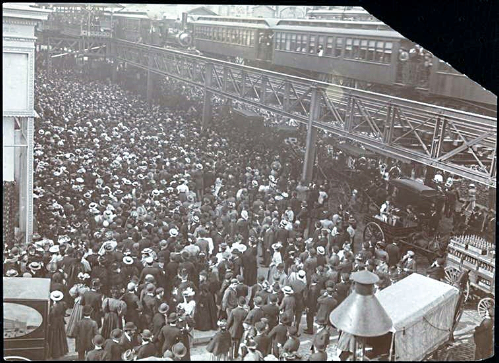
The article is titled “Jam at Siegel-
“The jam was so fast that the captain himself and Policeman O’Malley and McKenna of the City Hall station were wedged in so between the crowd and the building that the captain nearly had his arm broken and McKenna was taken to the hospital with a rib crushed in. O’Malley had his foot badly crushed”
The mob scene or “jam” was apparently caused by a false rumor that bicycles would be sold for “pin-
Further details of the bedlam:
In September 1896 a rumor circulated that Siegel-
And it continued to grow.
An hour and a half later Police Captain Chapman estimated the number at 40,000, blocking 6th Avenue from 17th Street to 22nd. When the doors to the store were finally opened, one patrolman suffered two broken ribs in the crush of the crowd
Upstairs in the bicycle department “The counter was overturned. The railings were broken. Cases of wheels were knocked down and men in trying to extricate themselves stepped on the bicycles and broke some,” reported The New York Times. “During the trouble dresses were torn and a few women fainted. No one besides the policemen were hurt much.”
There had never been any bicycles on sale that day.
The problems of today in our society, in our politics and our economy, and in every other aspect of our current way of life have not arisen out of nowhere. They are not isolated modern phenomena. They are the end result of a long, long history of the outworkings of the good, the bad, and the ugly of human nature. Simplistic answers that rely on trying to restore an ideal, mythical American Way of Life are doomed to failure.
I don’t personally like the “fallout” of Walmart stores going in across the nation. But I’m not under any illusion that the problems they present are “some new thing.” What Walmart does may be despicable…but it’s not somehow “un-
It is my conviction that zealous modern American Christians who get swept up into trying to bolster a “movement” to somehow “return American society to its nature of a century ago” are investing their zeal in an erroneous goal. And frittering away their limited time, energy, and resources that could be much better invested in finding ways to share the gospel of Jesus Christ with a spiritually hungry generation.
It is also my conviction that if such folks could understand more of the factors of the past that have affected the present, they would be better equipped to move productively into the future.